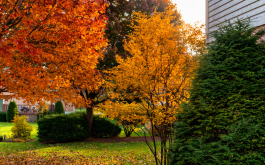The right kind of care is extremely important because healthy trees live longer. By taking proper care of your trees, you’ll also improve the look of your property and make it safer by preventing weak branches to break and fall under the weight of snow and ice.
1. Know your tree species.
The best way to take care of your trees and shrubs is to know the species. Three helpful tree identification resources (French version only) are the Mont Saint-Hilaire Biosphere Reserve’s tree identification tool, the mobile phone app Branché for trees in the City of Montreal, and a handbook like Michael D. Williams’ Guide éclair – Arbres du Québec (Éditions Broquet).
2. When to prune?
You need to prune your trees to preserve their vigour, stimulate growth, maintain symmetry, discourage harmful insects, prevent disease, and remove any branches that hang over buildings. However, each tree species has its own particular characteristics. For example, deciduous and conifer trees should be pruned during their dormant season before their buds open in the spring or after they have shed their leaves in the fall, because species like birch, maple, walnut and lime are bursting with sap in the spring. On the other hand, species like apple and mountain ash need to be pruned in early spring, as do young spruce, pine and fir.
3. How to prune?
Don’t prune back more than half of young conifer shoots. Also prune back branches of deciduous trees that bend inwards, rub against other branches, are broken, or are impeding passage. Avoid over-pruning fruit trees because this can stimulate the growth of many unproductive branches. Always prune close to the trunk or at forks, and completely remove side shoots (tiny branches on the trunk). In short: correct major defects while maintaining the tree's natural shape.
4. Maintain your trees.
It's better to water your trees for long periods than for a few minutes. Water that soaks the soil encourages deep root growth. Water a newly planted tree three times a week for the first month, twice a week for the second, once a week for the third, and then twice a month in subsequent years (once a week in case of drought). You can also spread mulch over a one-metre radius (from 2 to 10 cm thick), leaving the soil bare over a width of 5 cm from the trunk (to keep insects away).
5. Pay attention to overhead wires.
If your property is near a power line or is subject to an easement to that effect, you should know that Hydro-Québec regularly trims vegetation to protect its wires (for more specific information, check Hydro-Québec’s map and schedule and these FAQs, or call 1-888-385-7252). Before trimming any trees, always make sure your ladder does not touch any wires.
6. Prepare for winter.
Wrap the bottom of tree trunks with tape coated with a non-toxic rodent repellent, or with a tree guard that can be bought at garden centres. You can also install a snow fence (plastic or wood) or fabric cover to prevent damage from cold, de-icing salt or heavy snow.
7. Hire a professional.
For optimal tree care or to carry out potentially dangerous work at heights, you need to hire a professional arborist who will have their own professional liability insurance.
You need to maintain your trees every year to enhance healthy growth and protect your property. Also, for complete peace of mind, don't forget the importance of home insurance coverage that’s right for you.
Contact your broker to review your current home insurance policy or request a new quote.
